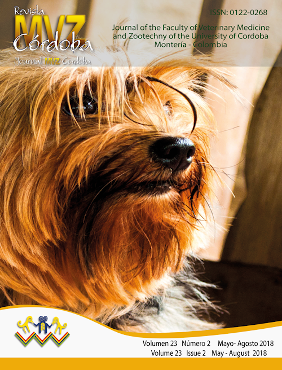Repercussion of microbial additive on the productive, Zoometric and diarrheal incidences of piglets
Repercusión de aditivos microbianos en el comportamiento productivo, zoométrico e incidencia diarreica de lechones
Show authors biography
Objective. To evaluate the impact of two microbial additives on the productive behavior, zoometric, incidence of diarrhea and mortality of post-weaning piglets. Materials and methods. A total of 120 piglets (Duroc / Yorkshire / Landrace) were used, divided into three groups of 40 animals each, control (T1); microbial preparation A (T2) and microbial preparation B (T3). The T1 contained Lactobacillus acidophilus, Lactobacillus bulgaricus y Streptoccus thermophilus. The T2 was composed of microorganisms of T1 plus Saccharomyces cerevisae and Kluyveromyces fragilis (L-4 UCLV). We used a completely randomized design where we evaluated, live weight, daily mean gain, height: raised at the cross, raised to the rump, body length, for both sexes and diarrheal incidence and mortality. Results. Live weight in the offspring (males and females) consuming microbial additives were higher and of these were higher in T3. Regarding the average daily gain, the largest increases were found in T3 group. Elevated to the cross, raised to the rump and length of body was greater (p<0.05) in T2 and T3 at birth; while at the end of the study in T3 it was superior. The incidence of diarrhea was higher (p<0.05) in the control group. The animals of the groups that consumed microbial preparation had no deaths during the study. Conclusions. The use of the microbial additives evaluated had a positive effect on the productive and zoometric behavior of the piglets. In addition, the reduction of the incidence of diarrhea and mortality of the animals was achieved.
Article visits 1994 | PDF visits
Downloads
- Sun Y, Park I, Guo J, Weaver A, Woo S. Impacts of low level aflatoxin in feed and the use of modified yeast cell wall extract on growth and health of nursery pigs. J Anim Nutr. 2015; 1(3):177-183. https://doi.org/10.1016/j.aninu.2015.08.012
- Datt C, Malik S., Datta M. Effect of probiotics supplementation on feed consumption, nutrient digestibility and growth performance in crossbred pigs under Tripura climate. Indian J Anim Nutr. 2011; 28(3):331-335.
- Miranda JE, Marin A, Ba-o D. Elaboration of a bioprepared with probiotic effect from a mixed culture of lactic bacteria and yeasts. Bionatura. 2017; 2(1):245-247. https://doi.org/10.21931/RB/2017.02.01.6
- Haffner F, Diab R, Pasc A. Encapsulation of probiotics: insights into academic and industrial approaches. AIMS Materials Science. 2016; 3(1):114-136. https://doi.org/10.3934/matersci.2016.1.114
- Zhao PY, Jung JH, Kim IH. Effect of mannan oligosaccharides and fructan on growth performance, nutrient digestibility, blood profile, and diarrhea score in weanling pigs. J Anim Sci. 2015; 90(3):833-839. https://doi.org/10.2527/jas.2011-3921
- Patil AK, Kumar S, Verma AK, Baghel PS. Probiotics as feed additives in weaned pigs. LRI 2015; 3(2):31-39.
- Ihara Y, Hyodo H, Sukegawa S, Murakami H, Morimatsu F. Isolation, characterization, and effect of administration in vivo, a novel probiotic strain from pig feces. Anim Sci J. 2013; 84(5):434-441. https://doi.org/10.1111/asj.12020
- Li J, Kim IH. Effects of Saccharomyces cerevisiae cell wall extract and poplar propolis ethanol extract supplementation on growth performance, digestibility, blood profile, fecal microbiota and fecal noxious gas emissions in growing pigs. Anim Sci J. 2014; 85(6):698–705. https://doi.org/10.1111/asj.12195
- Pajarillo E, Chae J, Balolong M, Kim H, Kang D. Assessment of fecal bacterial diversity among healthy piglets during the weaning transition. J Gen Appl Microbiol. 2014; 60(4):140‒146. https://doi.org/10.2323/jgam.60.140
- National Research Council (NRC). Nutrient Requirements of Swine: Eleventh Revised Edition. Washington, DC: The National Academies. 2012
- Coates J, Corns PJ, Juarez A, MacDonald R, McCulley N, Melody B, Minton A, Molinari R, Montes De Oca H, Mosqueira P, Neill C, Pinilla JC, Piva J, Teuber R. Manual PIC de Manejo de Hembras y Primerizas. 100 Bluegrass Commons Blvd: Suite 2200: Hendersonville, EEUU; 2013.
- Castro G, Montenegro M, Barlocco N, Vadell A, Gagliardi R, Llambí S. Caracterización zoométrica en el cerdo pampa rocha de Uruguay (descriptiva primaria). AICA. 2012; 2:83-86.
- Duncan DB. Multiple range and multiple F tests. Biometrics 1955;11:1. https://doi.org/10.2307/3001478
- Ayala L, Bocourt R, Castro M, Milian G, Oliva D, Herrera M. Suministro de un cultivo de Bacillus subtilis a cerdas gestantes. Respuesta productiva en su descendencia. Rev Comput Prod Porc. 2012; 19(4):260-263.
- Rondón A, Ojito Y, Arteaga F, Laurencio M, Milián G, Pérez Y. Efecto probiótico de Lactobacillus salivarius C 65 en indicadores productivos y de salud de cerdos lactantes. Rev Cub Cien Agr. 2013; 74(4):401-407.
- Lähteinen T, Rinttilä T, Koort MK, Kant R, Levonen K, Jakava-Viljanen M, Björkroth J, Palva A. Effect of a multi species lactobacillus formulation as a feeding supplement on the performance and immune function of piglets. Livest Sci. 2015; 180:164–171. https://doi.org/10.1016/j.livsci.2015.07.016
- Begum M, Li HL, Hossain MM, Kim IH. Dietary bromelain-C.3.4.22.32 supplementation improves performance and gut health in sows and piglets. Livest Sci. 2015; 180:177-182. https://doi.org/10.1016/j.livsci.2015.07.013
























